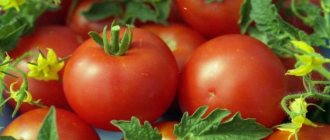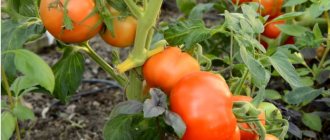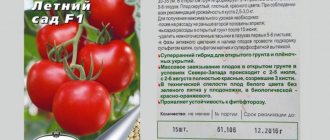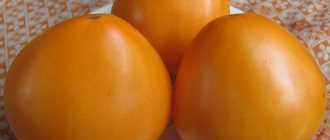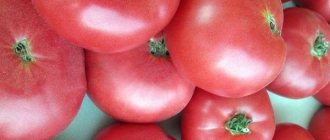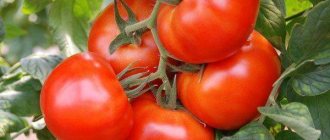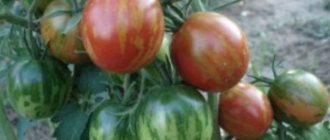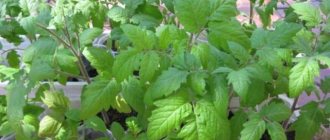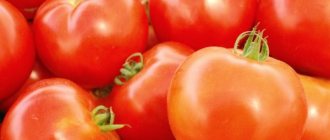Some varieties of tomatoes can be grown without using seedlings. There are many ways to cultivate such tomatoes. Growing full-fledged seedlings is not easy, so amateur gardeners often buy them at the market, which usually poses a certain risk of purchasing insufficient quality or the wrong variety.
The way out of this situation is the seedless method of growing tomatoes. Tomato seeds are sown directly into the ground where they grow continuously. It should be borne in mind that using this method it is possible to grow tomatoes both in the southern regions and in areas with a cooler climate.
We grow tomatoes without seedlings - varieties, advantages and disadvantages of the method
Due to the short summer in many regions of our country, tomatoes have to be grown through seedlings. In spring, caring for seedlings takes a lot of time and effort, leaving no time for other things. Recently, many gardeners have been thinking about how to simplify the process of growing tomato seedlings, and some, in general, grow this vegetable using the seedless method. This method is not new; it has been used successfully in the southern regions for a long time. Today, gardeners in central Russia and even more northern regions are mastering the seedless method of growing tomatoes . We will talk about its advantages and disadvantages and about the varieties of tomatoes suitable for sowing in open ground in the article.
We grow tomatoes without seedlings - varieties, advantages and disadvantages of the method.
Tomato care
Tomatoes without seedlings are cared for correctly; they require more attention from the gardener. In a greenhouse, control of light, humidity and air temperature comes first. In hot weather, fruit set will be poor.
In open ground, you must not overdo it with watering and fertilizing.
Stepsoning
For indeterminates, it is important to remove stepchildren. After breaking off the bushes, fresh places where the shoots were removed are sprinkled with activated carbon or treated with Bordeaux mixture.
For low-growing tomatoes, pinching is not necessary. If there are a lot of stems, then you can remove some of them.
Irrigation and fertilizing of bushes
Water tomato bushes sparingly. This is especially true for greenhouse plants. Increased soil moisture will become a source of development of pathogenic fungi.
Tomatoes are fed every 12-14 days, first with organic fertilizers. To do this, water with a solution of chicken manure in a ratio of 1:12 or mullein - 1:6. As the plants grow, fertilizers containing phosphorus and potassium are applied. Substances are needed for better flowering and fruiting of vegetable crops.
Shaping and garter
Bushes are formed by pinching. Tall ones need to stop developing in time, so the top of them is pinched, leaving 2-3 leaves above the top tying brush. Also, long stems require garter. For this purpose, trellises are built in the greenhouse, and pegs are stuck in the street next to the tomato stem.
Determinants rarely require bush formation. Only those that are very spreading will have to say goodbye to part of the stems.
Advantages of growing tomatoes without seedlings
Like any method, the seedless growing method has both positive and negative aspects. Knowing the nuances, you can assess whether this method is right for you and plan your work so as not to make mistakes.
The advantages of growing tomatoes by sowing in open ground are as follows:
- All labor-intensive processes of growing seedlings are eliminated - harvesting land, sowing, picking, watering seedlings, etc. Space is freed up for growing crops that cannot be grown without seedlings, for example, peppers and eggplants.
- If we are talking about growing tomatoes for sale, then by reducing the number of labor-intensive operations, the cost of production is significantly reduced.
- “Home seedlings” grown in conditions of lack of light are not always of good quality. And this may further affect the harvest - flowering and fruiting are delayed in weak seedlings. The seedless method helps solve the problem of weakened, elongated seedlings. Tomatoes sown directly into the ground grow strong and stocky.
- This method is relevant for those gardeners who were unable to sow tomatoes for seedlings in time. There is still an opportunity to grow “your own” varieties of tomatoes, rather than buying unknown ones.
- “Seedless tomatoes” grow hardened and adapted to growing conditions. In the future, such plants will be more hardy and resistant to disease.
- Plants grown without picking are distinguished by a powerful tap-type root system. The roots of such tomatoes go deep into the soil, up to 1.5 meters. Such plants require less watering, which means that in this case the amount of work required to care for the plants is reduced.
- When planting tomato seeds directly in the ground, the period from germination to fruiting is shortened - tomatoes grown without seedlings develop faster. The harvest of these tomatoes ripens approximately from the beginning of August, that is, not much later than those grown in the traditional way.
- This may not be important for all gardeners, but the amount of seedlings transported from the city to the dacha is decreasing.
When sowing tomato seeds directly into the soil, the period from germination to fruiting is reduced.
Take note
A seedless bed of tomatoes in open and closed ground begins to bear fruit a little later, about 2 weeks. For earlier consumption of fresh vegetables, experienced summer residents plant a small bed of very early tomatoes using the seedling method.
The good thing about the seedless technology for growing tomatoes is that all operations for caring for the garden bed are kept to a minimum.
Boxes with seedlings on window sills, additional lighting, diving, transplanting - how many labor-intensive operations can be avoided if you use this method. Don’t forget that the number of waterings and treatments will be reduced, which means the tomatoes will be tastier and safer, without the admixture of chemicals.
Negative aspects of growing tomatoes without seedlings
But in this business, as in any other, there are also disadvantages that prevent many gardeners from completely switching to growing tomatoes without seedlings.
The main negative point in growing tomatoes by direct sowing in the ground is the dependence of the sowing time on weather conditions. Tomatoes are heat-loving plants; the minimum temperature for plant growth should be at least +15°C. Therefore, it is difficult to determine the exact sowing date; each year it will depend on actual weather conditions.
Summer in central Russia is short; truly comfortable weather for tomatoes occurs in the months of June–July; in August the nights are already cool, and as a rule, dew falls. When it gets cold and there are sudden temperature changes, the growth of tomatoes slows down. The risk of late blight increases.
It turns out that even with the accelerated growth of stronger and more resilient plants from seeds, there is not enough time for their development. For the earliest varieties of tomatoes, the time from germination to fruiting is about 90 days.
When growing tomatoes in the traditional way, seedlings are planted in the ground at the age of 55–60 days. Such plants manage to produce their harvest in the optimal time. Therefore, it is possible to quickly grow tomatoes using seedless technology only in protected soil. Very early varieties of tomatoes are usually short-growing, so there is no point in growing them in high greenhouses. This means that if there are none, you need to plan to install arcs with covering material over the bed with tomatoes.
Ideal if you already have a “warm” or high bed. In them, sowing can be done much earlier, and fruiting will last longer.
Another drawback is that tomatoes sown using this technology ripen 2 weeks later. But if you plan your plantings wisely and grow some of the early varieties through seedlings, then the issue will be resolved.
Another important aspect is that not all varieties and hybrids of tomatoes are suitable for growing using this method.
Tomato "Seedless (Sprint-2)".
Iceberg tomato.
Tomato "Duckling".
Productivity
The success of growing is determined by timely compliance with all the rules and nuances of watering, fertilizing and caring for tomatoes.
Productivity reaches up to 8 kilograms per square meter.
The density of plants depends on the maturation of the species. For early-ripening varieties with low-growing compact plants, 90-100 thousand are formed per hectare, mid-ripening - 70-90 and mid-late - 55-70 thousand per hectare, or 55-70 pieces per 10 square meter. Pelleting becomes an effective method of preparing seedlings. Thanks to this method, the planting rate will be 6-7 kilograms per 1 hectare, which is 550-650 thousand viable seeds. This is a fairly large amount for a tomato harvest. Productivity reaches up to 8 kilograms per square meter
Proper and timely care of tomato seedlings will help to reap a large harvest and will delight the gardener with its seedlings.
What varieties of tomatoes can be grown without seedlings in the middle zone?
Tomato varieties should not only be very early, but also cold-resistant, resistant to diseases and temperature changes. It’s good if the packaging with seeds says: “Suitable for growing without seedlings.” But there are few such varieties, among them: “Amur Standard” , “Bezrassadny (Sprint-2)” , “Spring Frosts” , “Explosion” , “Far North” , “Subarctic” , “Yamal” .
In addition to these varieties, you should pay attention to the following varieties. They belong to the early and super early varieties, are unpretentious in cultivation, and are resistant to weather changes:
- "Iceberg" - early, cold-resistant, resistant to temperature changes.
- “Juggler” from breeder L. A. Myazina is drought-resistant, heat-resistant, and resistant to low temperatures.
- "Leopold" is ultra-early ripening, cold-resistant, undemanding to care, resistant to major tomato diseases.
- “Duckling” is early, disease resistant. It is distinguished by good fruit set even in unfavorable conditions and uniform fruiting.
- “Lollipop” tomato is incredibly unpretentious and productive; it belongs to very early varieties.
- “Leningrad Chill” is super early and has exceptional cold resistance.
- “Severyanin” is an ultra-early plant that sets fruit well at low temperatures.
You can also sow tomato varieties “Boni MM” , “Flash” , Gnome , “Sanka , “Bullfinch” , “Snowdrop” , “Shuttle” , “Apples on the Snow” .
When the tomato seedlings have 2-3 true leaves, you will need to leave the strongest sprout and remove the rest.
Description and characteristics of the variety
The Besrassadny variety “Ural Estate” was created specifically to sow areas on an industrial scale without wasting extra time. It can be grown both for sale and for yourself in the garden.
The bush is determinate, low-growing and low-branched. Having reached 40 cm in height, it stops growing on its own. It begins to bloom after the appearance of 6-7 leaves, the ovaries are collected in a brush of 6-8 pieces. The round red fruits weigh approximately 100-110 grams and are well suited for preservation and consumption in salads, juices, and pastes. This is an early variety, the first harvest can be harvested 100-110 days after planting.
Country of origin, growing regions
The variety was bred on the basis of a number of soil-resistant tomatoes that are resistant to cold, which were developed by the Soviet breeder Pavel Saraev. The growing regions include the entire territory of the Russian Federation, Ukraine and Moldova. It is also suitable for areas of risky farming: high yields are observed in a number of regions from Pomerania and Karelia to Siberia and the Urals.
Technology of planting tomatoes using the seedless method
The technology of growing tomatoes without seedlings in central Russia is not yet used so often, so I will try to describe in detail all its stages.
To make it clear, I will repeat once again: tomatoes are heat-loving plants and enough time passes from sowing to harvesting (their growing season is long). Therefore, the gardener’s task is to create optimal conditions for these plants as early as possible.
The first step is choosing the right landing site. The bed should be in the sunniest place, protected from the wind, and in no case in a lowland.
As soon as the snow melts, the bed should be covered with black film, pressing its edges tightly with boards or other materials. If the weather is sunny, then in about a week the soil will warm up and you can start sowing.
Of course, it’s good if the bed has been prepared in the fall, but it often happens that we don’t always think through the next season’s plantings in advance.
If the bed is not ready for planting, then it is better to cover it directly in the snow with black film so that the snow melts faster. As soon as the snow melts and the soil dries out a little, you will need to add compost or humus to it and dig it up. Under no circumstances should you add fresh manure to sowing; you should also not add ash, as young seedlings can be burned.
I have already said that it is ideal if you already have a prepared “warm bed”. Due to the fact that biochemical processes occur in it, there is a gradual decomposition of organic matter with the release of heat. Such a bed can be used for planting much earlier in the spring.
Next, you need to think about how you will protect your crops from cold and temperature changes. There are several options here:
- Some leave the film until the shoots begin to appear, but this method is not suitable for those gardeners who come to the site only on weekends.
- Some people cover their crops with cut-off plastic water bottles. In this case, you will need to remove the caps from the bottles. And above the bottles themselves it’s a good idea to place arcs with a covering material (spunbond, agril, etc.).
- According to reviews from experienced gardeners, the best way is to install arcs on which you will need to stretch the film. And after sowing, cover the bed itself with covering material. Covering material will help retain moisture, conserve heat, and protect seedlings from burns from direct sunlight. In the future, when constant warm weather sets in and the seedlings grow, the film from the arcs can be replaced with spunbond.
Another important point: young seedlings can be destroyed by mole crickets. If you have such a pest, then you need to take care of your crops: dig jars without a bottom (from canned food, dairy products) into the ground and sow in them.
Tomato "Explosion"
Tomato "Juggler"
Tomato “Apples in the snow”.
Ground sowing
It is recommended to plant early tomatoes in small bushes using the seedless method. They are not afraid of dense plantings; it is better to place them in a checkerboard pattern at a distance of 30 cm between plants.
In order to ensure air access to the plants in the future, the stepsons should be cut off in a timely manner. You can sow up to 5 seeds in one hole and cover them with a one and a half centimeter layer of soil. After this, be sure to pour warm water over it and cover it with cut-off plastic bottles or glass jars. Be sure to cover the top with a film stretched over the arcs.
How to care for crops?
When the seedlings have 2-3 true leaves, you will need to leave the strongest sprout and remove the rest. To stimulate the growth of the tap root, and not the lateral ones, the grown seedlings need to be watered not next to the stem, but retreating a few centimeters. In this way, a developed tap-type root system is formed.
Subsequent care of seedlings depends on the weather. If the weather is hot, then it is necessary, gradually accustoming the plants to changes in temperature and humidity, to remove some of the shelters - jars, film, leaving the seedlings under arches with covering material. If it is still cold, then you need to take care of additional shelter.
In the future, the scheme for growing tomatoes without seedlings does not differ from growing using conventional technology. That is, the plants will need to be fed with fertilizers, if necessary, they will need to be planted and protected from diseases. But they will need to be watered much less often.
Of course, it’s tempting to simplify the process of growing tomatoes so much that you can get rid of the hassle of growing seedlings. But any technology has both positive and negative sides that must be taken into account so as not to be left without a harvest.
The positive aspects of growing tomatoes without seedlings still outweigh the disadvantages. Growing tomatoes without seedlings is a new and interesting experience - one step towards the so-called “garden without the hassle” that many people dream of. Try it yourself, because without your own experience it is difficult to judge anything.
Planting and care
Seeds are sown at the end of April. The width of the beds should be 120-150 cm. They are fertilized with humus in the amount of 1 bucket per square meter, as well as with ash. The ground should be mulched with peat or sand. The grains are placed in furrows 10-12 cm deep or in holes 20 cm in diameter, 5 pieces per hole. Having covered the seeds with soil, the bed is covered with film to retain heat. No need to water.
After 7-10 days, shoots will appear, then the film is removed. However, young shoots still need protection, so they are covered until the threat of cold weather disappears.
Plants are thinned out when they have 3-4 full leaves.
Watering - once every 7-10 days, fertilizing twice a season. From time to time you should loosen the soil and weed out the weeds.
Recommended tomato varieties
Ultra-early / Low-growing
Nepas 11 non-sinkable indoor user rating: 4/5
Mid-early / Low-growing
Perseus User rating: 5/5
Mid-season / Low-growing
Wild Fred User rating: 4/5
Ultra-early / Low-growing
Boni MM User rating: 5/5
How to grow tomatoes without seedlings: pros and cons of technology
To grow tomatoes on a personal plot, seedling technology is traditionally used - seedlings are grown independently or purchased at the market. Not everyone can grow high-quality seedlings. There are many reasons for this: there are no suitable conditions or there is not enough time. Buying ready-made seedlings on the market is not the best solution. Inappropriate variety, overfeeding with nitrogen fertilizers - the results can be unpredictable.
Seedless tomatoes - the pros and cons of the method
Tomato seeds of your favorite variety can be sown immediately in a permanent place.
Contrary to popular belief, a rich harvest can be harvested not only in the south. The whole process can be described in one phrase: prepared seeds are planted in a prepared bed and fruits of excellent quality are obtained, right up to frost.
This method of agricultural technology has more advantages than disadvantages:
- No hassle with growing seedlings in a city apartment. There is no need to purchase seedlings of an unknown variety with an unpredictable harvest on the market.
- There is no need to spend money on seedling boxes, soil, or additional lighting lamps. Labor-intensive operations for caring for seedlings (picking, hardening, transplanting, etc.) are also not necessary.
- From the first days of growth, seedlings undergo natural hardening: they grow strong and healthy, bearing fruit until late autumn.
- Without diving or transplanting, the root system of the bush develops continuously and reaches a depth of up to 1.5 m. Tomatoes practically do not require watering.
- Hardened plants with a strong root system hardly get sick and produce fruits with a rich taste.
- The collected seeds of non-seedling tomatoes completely repeat the properties of the mother plant - you can prepare seed material for several years.
How to grow tomatoes in a greenhouse
How to grow tomatoes without seedlings? Arcs are used to tension the coating. Before installing them, the beds are dug up and compost or humus is added. To insulate the ridges, it would be good to make wooden boards along the edges. The beds are made in the same way in the greenhouse. Here you can warm the beds from the inside with a layer of manure.
The manure should not be completely fresh and covered with a sufficient layer of soil so as not to burn the roots of the plants.
Before you start preparing the ground for tomato planting, be sure to pour hot water over the selected area. It is good to add manganese for disinfection.
Then, do not forget to maintain the time and planting scheme for tomatoes:
- Sowing is carried out at the end of April (if the weather is favorable) and until mid-May.
- The nesting method has proven itself well, in which up to 5 seeds are sown in one hole. This allows you to leave the strongest seedling in the future.
- It looks strong, the leaves are dark green, the internodes are short, the root is deep in the ground.
So, in order to grow a good crop of tomatoes in a greenhouse, you will need to do the following:
- thin out seedlings;
- mulch the holes with compost;
- pinch out the stepsons after two weeks to maintain their single-stem shape;
- remove growing points after creating 3-4 brushes for pouring fruit;
- remove the fruits from the lower cluster unripe for further ripening;
- remove lower leaves and shoots using pruning shears;
- get a good harvest from the top clusters.
Growing tomatoes without seedlings is practiced both in open ground and in a greenhouse. The second option is very successful:
- During a long spring. A tomato grown in a greenhouse is reliably protected, especially when the owner is away from the site.
- In addition, before warming, it is convenient to grow tomatoes in a greenhouse and then transplant them into open ground. Tomatoes should not be tall and spreading, so it is important to pay attention to the choice of variety.
- Bushes grown in greenhouses are planted in open ground and first covered with non-woven material. This will speed up the period of fruit ripening and protect the tomatoes from the vagaries of the weather.
